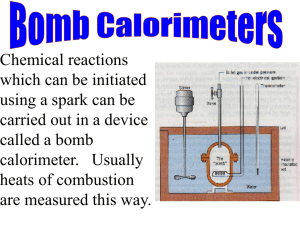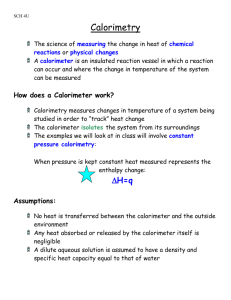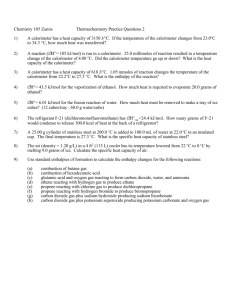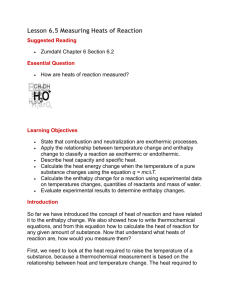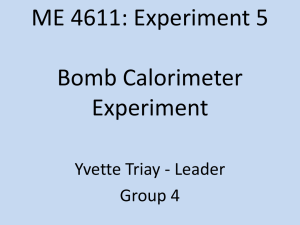MEEN 3242 MEE LAB II
advertisement
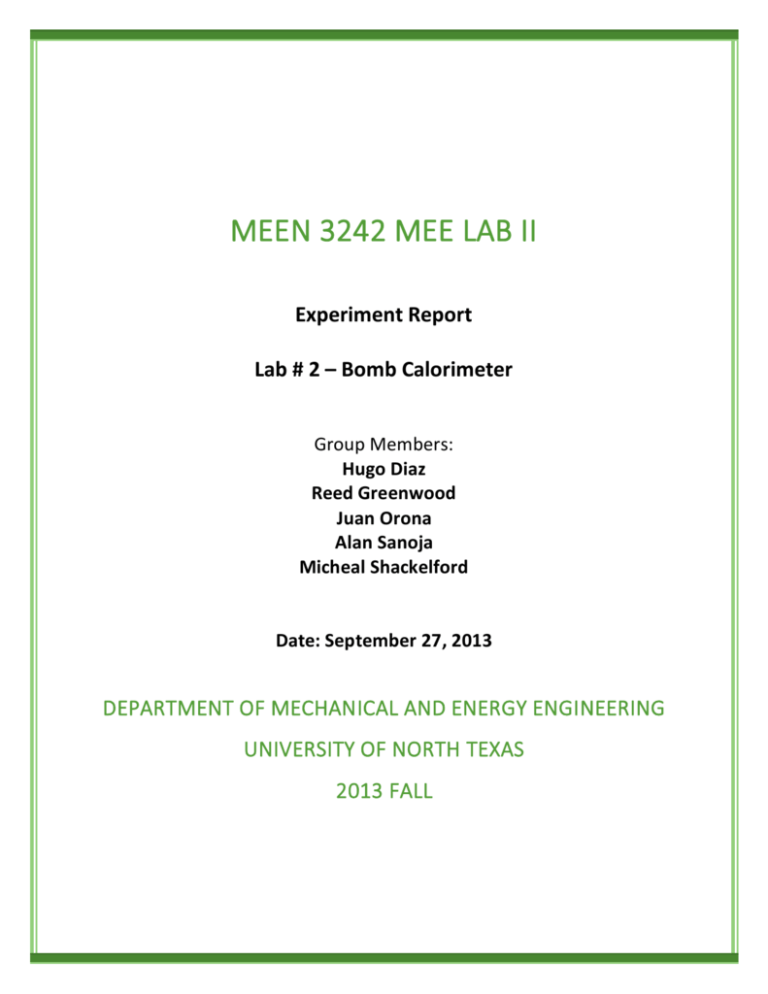
MEEN 3242 MEE LAB II Experiment Report Lab # 2 – Bomb Calorimeter Group Members: Hugo Diaz Reed Greenwood Juan Orona Alan Sanoja Micheal Shackelford Date: September 27, 2013 DEPARTMENT OF MECHANICAL AND ENERGY ENGINEERING UNIVERSITY OF NORTH TEXAS 2013 FALL Lab #2 – Bomb Calorimeter CONTENTS 1. Introduction ............................................................................................................................................................... 2 2. Background and theory ............................................................................................................................................. 3 3. Procedure .................................................................................................................................................................. 5 4. Results and Conclusion ............................................................................................................................................ 10 5. Uncertainty Analysis ................................................................................................................................................ 13 6. Conclusion ............................................................................................................................................................... 14 7. References ............................................................................................................................................................... 15 8. Team Members photo ............................................................................................................................................. 16 9. Data Sheet (Scanned copy) ...................................................................................................................................... 17 1. INTRODUCTION Abstract In this experiment we measured the energy density for flammin’ hot cheetos using a bomb calorimeter. We burn benzoic acid to find out the heat capacity of the equipment and we then burned a small amount of the flammin’ cheetos. We got [value] for the energy density of the cheetos, and the value on the nutrition label is [value]. We can see that our values are [compare] to the value on the label. Introduction In this experiment we will be using a bomb calorimeter. A bomb calorimeter measures the heat combustion during a reaction. This will allow us to measure the amount of calories contained in hot Cheetos and be able to compare the results to the value on the nutrition label. We will first find out the heat capacity of the calorimeter using benzoic acid, since it fully combusts in oxygen. The bomb 2 Lab #2 – Bomb Calorimeter calorimeter is a closed system, therefore there is no heat transfer with the surroundings and we will be able to use the First Law of Thermodynamics, conservation of energy, to find out the necessary values. (Traum, 2009) 2. BACKGROUND AND THEORY Bomb calorimetry is a process which can be used to determine the heat of combustion or calorific value of a solid or a liquid material. The Bomb Calorimeter was invented by a great chemist in the 18th century named Marcellin Berthelot. A simple liquid or food is compressed with oxygen inside a sample container or sample cup within the bomb calorimeter. The bomb calorimeter is ignited producing heat to the samples, which is then measured by the change in temperature of the surrounding water. In figure 1 we can see that the system is a closed system there is no heat exchange between the surrounds or calorimeter making it an adiabatic system. Figure 1. Bomb Calorimeter( McMurray Fay, Chemistry Fourth Edition) 3 Lab #2 – Bomb Calorimeter Applying first law of thermodynamics allows the use of the following equations. Since there work is no being done or heat being absorbed by the system, the total energy change is zero allowing the following question to be valid. Once the sample is burnt, heat released is then absorbed through the water which provides a set of different temperature readings that is provided by the Bomb Calorimeter. There are a couple procedures that must be followed in order to obtain the proper results. It is important to evaluate the unknown heat capacity of the bomb calorimeter using Benzoic Acid, a known substance that combusts completely in oxygen. There a couple of equations that can be used throughout the procedure. By using the specific heat capacity of water which is 4.2 KJ/KgK and the given nutrition facts of the sample, we can determine if the results discovered are equal or match what is given on the nutrition label. 4 Lab #2 – Bomb Calorimeter 3. PROCEDURE . [Oxygen distribution system] Experimental Equipment [IKA C2000 Calorimeter] 5 [Mettler Toledo] Lab #2 – Bomb Calorimeter 6 Lab #2 – Bomb Calorimeter [Multi-meter & type K thermocouple] [Pitcher] Procedures 1. Empty the calorimeter containment vessel and combustion crucible. Put together the containment vessel (or “bomb”) using an empty combustion crucible. 2. Initiate power to the IKA C200 bomb calorimeter. 3. Determine the mass of water used by the calorimeter, thread on the white plastic ignition cap to the containment vessel. Put the sealed, empty containment vessel that has been sealed and capped into the calorimeter cavity. Close the lid securely. 4. Pour the water in the pitcher into the calorimeter reservoir tank. The liquid level should be between the high and low marks on the reservoir tank. Please fill reservoir to above the minimum level. 5. Weigh the pitcher on the Mettler-Toledo high-capacity balance then write down its weight and the uncertainty associated with this measurement. 6. In the calorimeter action screen, Press “Prepare” and use the default values only. Press “O.K” (F1) 7. Once the “Storage Filled” prompt appears, Press “continue” (F1) to fill the calorimeter fluid jacket. 8. Put the collection pitcher under the calorimeter drainage tube to catch the expelled water. 9. After the calorimeter fluid jacket is full, the calorimeter will start “Equalizing”. When this happens abort the experiment by opening the calorimeter lid. This will causes the calorimeter to drain into the graduated fluid collection pitcher. This may take several minutes 10. Place the now full graduated fluid collection pitcher upon the Mettler-Toledo highcapacity balance and record its weight and the associated uncertainty. The difference between the full and empty pitcher weight is the mass of water used by the calorimeter. 11. Repeat Steps 3 –10 11 times. Use the average of the 11 resulting mass measurements of the water used by the calorimeter. Substitute the standard deviation for the uncertainty of the mas of the water. Don’t use the first measurement if this data point 7 Lab #2 – Bomb Calorimeter is way off from the previous measurements. 12. Put the empty crucible on the Mettler-Toledo high-precision balance. Zero or tare the scale (calibrate), then put ONE tablet of benzoic acid in the combustion crucible and weigh again to get the mass of the benzoic acid tablet. This is needed for later calculations. The energy density of the acid is given as 26460 J/g. Please note this Acid is an eye and skin irritant. Use gloves provided when handling this substance. 13. Un screw the calorimeter containment vessel lid and mount the benzoic acid -filled crucible inside. 14. Thread one piece of cotton over the containment vessel as an ignition wire. Be sure to assure the twine is contacting with the acid tablet. 15. Screw the lid back on to the combustion chamber, sealing it hand tight. 16. Connect the sealed, assembled, loaded containment vessel to the oxygen gas filling station 17. Open the oxygen gas tank to release the gas. 18. Dial in the gas tank regulator to 30 bar. The check valve on the gas tank regulator may open with an audible hiss. Quickly disengage the combustion chamber from the fill assembly. DO NOT overfill the chamber. If the chamber is accidentally overfilled bleed it off with the pressure relief tool and repeat Steps 16 – 18. 19. Put the gas charged containment vessel onto the calorimeter cavity. Insert the thermocouple into the calorimeter cavity. Close the lid. 20. At the calorimeter action screen Press “Prepare” (F2) and accept all the default values, press “O.K” (F1). 21. Put the water in the pitcher into reservoir tank. 22. Put the pitcher under the calorimeter drainage tube to catch the discharge water. 23. When the “Storage Filled” prompt appears, Press “continue” (F1) to fill the calorimeter fluid jacket. 24. After the calorimeter fluid jacket is full, read the thermocouple reader for water temperature. Record this value. 25. Each minute after, record water temperature from the thermocouple reader for about 10 minutes (collect 10 data points, you need this to calculate the mean and standard deviation of the initial temperatures) in order to ensure the temperature of the 8 Lab #2 – Bomb Calorimeter calorimeter becomes stable. The average will be the initial temperatures of the water. 26. Once 10 data points have been collected, press the “Ignition” (F1) button. 27. If ignition is successful, you will see the water temperature starts increase. If not, ask the T / A for help. Possible reasons could be the cotton wick is not touching the food sample adequately, or the Bomb is not placed on the right position. 28. Record water temperature from the thermocouple reader for another 15 minutes (once a minute) to ensure the temperature inside the calorimeter be come’s stable. When the temperature starts decrease, collect another five data points. 29. Remove the Bomb, and towel dry it, and use the pressure relief valve to relieve pressure. 30. Remove the crucible from the chamber. Note whether it contains residue or ash. Weigh the crucible and any remaining ash on the Mettler-Toledo high precision balance. Record this value while noting the difference is the actual amount of Benzoic acid that burnt. 31. Repeat steps 12 - 30, but this time uses your food sample Do not use food sample with a mass over 2 grams. Note the caloric value of the food sample from the nutrition facts label. This information is needed for later comparison. 9 Lab #2 – Bomb Calorimeter 4. RESULTS AND CONCLUSION Water(g) Pitcher Run 1 2108 186 Run 2 Run 3 2089 2098 186 186 Run 4 Run 5 2085 2104 186 185 Run 6 Run 7 2085 2103 186 186 Run 8 Run 9 2101 2092 186 186 2106 2097.1 186 185.9 Run 10 Average Standard Deviation Water Benzonic Acid Burn 1.0166 grams ignited 8.698020209 0.316228 1911.2 ml Temp (C°) Time (s) 21.8 60 21.9 21.8 120 180 21.8 21.8 240 300 21.8 21.8 360 420 21.9 22.5 480 540 22.8 23 600 660 23.1 720 23.2 780 23.2 840 ∆T (C°) 1.4 10 Lab #2 – Bomb Calorimeter Flamin Hot Cheetos .6829 grams ignited ∆T (C°) Temp (C°) Time (s) 22.5 60 22.6 22.5 120 180 22.5 22.6 240 300 22.6 23 360 420 23.2 23.4 480 540 23.4 23.5 600 660 23.6 720 23.6 780 23.6 840 1.1 −𝑞𝑠𝑎𝑚𝑝𝑙𝑒 = 𝑞𝑐𝑎𝑙𝑜𝑟𝑖𝑚𝑒𝑡𝑒𝑟 +𝑤𝑎𝑡𝑒𝑟 𝐽 −𝑞𝑠𝑎𝑚𝑝𝑙𝑒 = − (26460 ) (1.0166 (𝑔)) = −26899.236 𝐽 𝑔 𝑞𝑐𝑎𝑙𝑜𝑟𝑖𝑚𝑒𝑡𝑒𝑟 = (𝑀𝑤𝑎𝑡𝑒𝑟 𝐶 + 𝑀𝑐𝑎𝑙𝑜𝑟𝑖𝑚𝑒𝑡𝑒𝑟 𝐶)∆𝑇 𝑀𝑐𝑎𝑙𝑜𝑟𝑖𝑚𝑒𝑡𝑒𝑟 𝐶 = 𝐻𝑒𝑎𝑡 𝐶𝑎𝑝𝑎𝑐𝑖𝑡𝑦 = 𝑀𝐶𝑎𝑙𝑜𝑟𝑖𝑚𝑒𝑡𝑒𝑟 𝐶 = [𝑞𝑠𝑎𝑚𝑝𝑙𝑒 − 𝑀𝑤𝑎𝑡𝑒𝑟 ∗ 𝐶 ∗ ∆𝑇] ∆𝑇 [26899.236 − (1911.2 ∗ 4.2 ∗ 1.4)] = 11186.7 𝐽/𝐶 1.4 −𝑞𝑠𝑎𝑚𝑝𝑙𝑒 = 𝑞𝑐𝑎𝑙𝑜𝑟𝑖𝑚𝑒𝑡𝑒𝑟 11 Lab #2 – Bomb Calorimeter 𝑞𝑐𝑎𝑙𝑜𝑟𝑖𝑚𝑒𝑡𝑒𝑟 = ℎ𝑒𝑎𝑡 𝑐𝑎𝑝𝑎𝑐𝑖𝑡𝑦 ∗ ∆𝑇 𝑞𝑐𝑎𝑙𝑜𝑟𝑖𝑚𝑒𝑡𝑒𝑟 = (11.1867 (12.305327 𝑘𝐽) ( 𝑘𝐽 𝐾 ) (1.1𝐾) = 12.305327 𝑘𝐽 𝑘𝑐𝑎𝑙 ) = 2.92985 𝐶𝑎𝑙𝑜𝑟𝑖𝑒𝑠 4.2𝑘𝐽 (Experimental Data) 12 Lab #2 – Bomb Calorimeter Sample Size = .6829 grams 28𝑔 = 160 𝑐𝑎𝑙𝑜𝑟𝑖𝑒𝑠 5.7142857 𝑐𝑎𝑙𝑜𝑟𝑖𝑒𝑠/𝑔𝑟𝑎𝑚 (. 6829 𝑔𝑟𝑎𝑚𝑠) (5.7142857 𝑐𝑎𝑙𝑜𝑟𝑖𝑒𝑠 ) = 3.9022 𝑔𝑟𝑎𝑚 (According to Manufacturer) 5. UNCERTAINTY ANALYSIS Uncertainty Analysis: 𝑄̇ 1 2𝜋𝑅𝑔2 = √(1/2(ℎ22 ∗ ℎ1 + ℎ21 ∗ ℎ2 )) The right hand side uncertainty evaluation is as follows: 𝑅𝐻𝑆 % 𝑒𝑟𝑟𝑜𝑟 = √3 ( ∆ℎ1 2 ∆ℎ2 ) + 3( ) = 1.05813 ∗ 100% = 105.813 % ℎ1 ℎ2 The left hand side uncertainty evaluation is as follows: 𝐿𝐻𝑆 % 𝑒𝑟𝑟𝑜𝑟 = √( ∆𝑄̇ 2 ∆𝑅 ) + ( )2 = .049076 ∗ 100% = 4.9076 % ̇ 𝑅 𝑄 13 Lab #2 – Bomb Calorimeter So the tolerances felt on the measurements are as follows: √1/2(ℎ22 ∗ ℎ1 + ℎ21 ∗ ℎ2 ) = 4.09755 ± 1.06 𝑄̇ 1 2𝜋𝑅𝑔2 = 51340.736 32391.8 = 1.64056 ± .05 6. CONCLUSION Although the data gives a reasonable number for the calories, it is not a perfect number. This is due to error that could have happened from the scale not being right, the food sample not burning completely, or the reading for the water temperature not being correct due to it being on the side of the container instead of in the middle of the water. (12.305327 𝑘𝐽) ( 𝑘𝑐𝑎𝑙 ) = 2.92985 𝐶𝑎𝑙𝑜𝑟𝑖𝑒𝑠 4.2𝑘𝐽 (Experimental Data) (. 6829 𝑔𝑟𝑎𝑚𝑠) (5.7142857 𝑐𝑎𝑙𝑜𝑟𝑖𝑒𝑠 ) = 3.9022 𝑔𝑟𝑎𝑚 (According to Manufacturer) Had we burned a larger sample we would have gotten a number closer to the manufacturer number. The small sample size allows other factors to be more influential to the final product. We were about 30% off the mark but had we run the experiment a few more time we would reduce the experimental errors along with human errors. 14 Lab #2 – Bomb Calorimeter 7. REFERENCES "Marcellin Berthelot." HowStuffWorks. Web. 25 Sept. 2013. Web<http://science.howstuffworks.com/dictionary/famous-scientists/chemists/marcellin-berthelotinfo.htm> Traum, D. M. (2009). Bomb Calorimetry. 15 Lab #2 – Bomb Calorimeter 8. TEAM MEMBERS PHOTO 16 Lab #2 – Bomb Calorimeter 9. DATA SHEET (SCANNED COPY) 17
